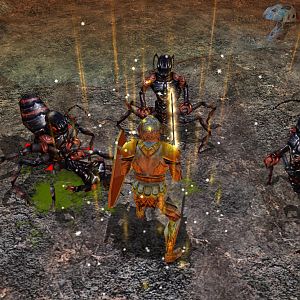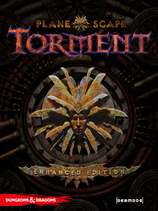-

- Forums
- Chatrooms
- Gallery
- Gameplay Videos
- Upload
- Articles
- Mod Reviews
- Shop SP: Games, Movies, Books

|
Baldur's
Gate 2 Review
|
Publisher:
Interplay
/ Black Isle
Studios So has the team at BioWare delivered another role-playing gem, or has the sophomore jinx caught up with the team? You can find out in our in-depth review of Baldur's Gate II: Shadows of Amn below, Enjoy! Gameplay Baldur’s Gate II plays similar to previous offerings published under the Black Isle Studios banner for their D&D licensed games. The biggest difference is the size of the game, and the nice mix of combat and quests. The introductions of a number of new character kits (about 3 per class), weapon proficiencies, classes, and even a new race have been implemented well. Also, the use of the D&D 2nd edition ruleset is very good as usual. Players are able to cast spells up to 7th level priest and 9th level wizard. Your characters start with 89,000 experience points, which equates to characters from levels 7th to 8th. The experience cap in the game is set at 2,950,000 allowing you to level your characters to a low of 14th (druids) all the way up to 23rd (thieves & bards). The rest of the character classes fall somewhere in between. Remember that 2,950,00 is the hard cap for experience point gain, so if you multi-class then your lump sum total of experience points will never exceed that. The interface is pretty easy to use, and not very difficult to learn. The available options for your character can be found at the bottom of the screen, with more information displayed on either side of the screen. Nothing more complicated than a few clicks will accomplish anything in the game, and the action can be paused at any point with relative ease as well. The game does stay paused now while you're digging through your inventory, which is a significant change from past titles. The high level of combat in the game is very challenging and similar to Icewind Dale, but much improved over the original Baldur’s Gate. Combat occurs in real-time, while each character does have a delay for their next attack round. Through the correct use of the pause button, players can effectively make the combat seem like a turn-based system. Projectile weapons are still effective, but not nearly as much. Melee weapons appear beefed up, perhaps this is because of the higher quality of magic items found in the game. Although the use of melee or projectile attacks are definitely not lacking in punch, Baldur’s Gate II favors the mage in most cases. Conjuring appears to still be the top school of magic due to the high saving throws major opponents have, and for the nice variety of creatures you can summon forth to do your fighting for you. As with previous Infinity Engine titles, a great journal is automatically updated as you progress with interesting information and quest entries. These entries are triggered by accepting / completing a quest or finding out something interesting from a NPC, and are separated by chapters. There is also a working map that gets put together as you make it to more areas, which makes travel easier especially later in the game. Speaking of maps, the running speed to get around these has been increased from Baldur's Gate, and the path finding AI, although far from perfect, is better as well. Unfortunately, you are not able to run in this one like you could in Planescape: Torment. Visuals
Aurals
The story is much better than what you found in Icewind Dale, but is a bit simpler than Planescape: Torment’s. Don’t worry about having to read a book in this one to finish. The combat while fun and challenging was pretty difficult at times. Save early and often is the best advice I can give you. Strategy plays a key role in all these fights, so make sure you develop yours early in this one. Hide in Shadows and Invisibility spells are some of the best in the game to explore an area so you can get your party set for what they are about to walk into. Familiar NPCs Imoen (thief / mage), Jaheira (fighter / druid), Edwin (Specialist Mage Conjurer), Viconia (Cleric), and Minsc (Ranger) from the first game in the series make an appearance in Baldur’s Gate II, and a whole slew of new NPCs make their debut as well. You have new characters ranging from the lovable gnome inventor Jan (thief / illusionist) to the axe crazed bloodthirsty dwarf Korgan. Although the game still favors those who are of neutral or higher alignment, there is the option to play a party that is primarily comprised of evil aligned characters. A total of 16 that can travel in your party are in the game. Should you do a lot of side quests, you can meet all these NPCs fairly early in the game. Each of the NPCs bring a unique personality to your party, and their own quest or two that you can help them out with. A lot of interaction with your main character and other party members is guaranteed, and there are four NPCs (three female and one male) that your character can romance. The quality of the NPCs in Baldur’s Gate II is much improved over those in Baldur’s Gate. Side quests in the game are abundant, and your character can become involved in many fairly quickly. In fact, if you played the game a few hours a night, you could easily spend three to four weeks in the large town of Athkatla alone without leaving the city gates. These side quests can range from fairly simple ones like finding an item for a NPC, to conducting an investigation on a religious cult in the area. Most side quests in the game are layered in that they build up to a final conclusion that might be totally different from what you began with. For instance, the aforementioned cult investigation will eventually become one in which you are asked to rid the area of the cult after you find out exactly what these deviants are up to. A large number of the side quests are fairly linear where the decisions you are given will just end the quest if you deviate from the path. However, there are larger side quests that have multiple endings. The one thing to keep in mind when doing large amounts of side quests is the reputation of your party. You don’t want to be acting like a Paladin solving all the problems of the land, while playing with evil aligned or even neutral party members if you become too extreme. The same goes in the other direction, only it seems about 10x more extreme. Those party members that feel your reputation is unacceptable will simply leave your party, and a bit quicker than they would in the original. One reason for this change is to help do away with people running to churches to buy back their reputation through donations, although it is still possible if you are close. Multiplayer Baldur's Gate II: Shadows of Amn comes with full multiplayer support that allows for up to six different people to join a game, i.e. the six members of your party in the single player game. Supported connections include LAN, the Internet via a TCP/IP connection, and direct connections (two players, head-to-head, cooperative mode) via modems or serial cables. It should be noted that there is no difference in the single and multiplayer versions of the game. The person that begins the game must stay logged in for the session to continue. Similar to my gripes about this aspect of the game in Icewind Dale, the multiplayer experience is the worst aspect of BG2. However, due to the sheer volume of people who are playing the game in comparison to Icewind, it is much easier to find a good game to join up with. The network connections and services provided are not actually flawed in any way, but is very apparent that, as was the case in past Infinity Engine games, Baldur's Gate II: Shadows of Amn offers a far superior experience as a single player game than a multiplayer one. Fun Factor
The Questions
| |||||||||||||||||||||||||||||||||||


